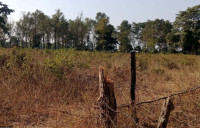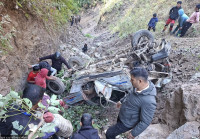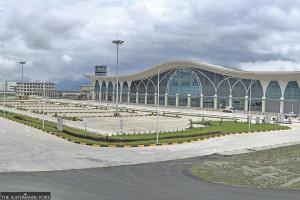National
No relief for Koshi farmers enduring losses in wildlife attacks
The process of securing relief is so long and arduous that many survivors simply give up.
Post National Bureau
Chetraj Ghimire, a farmer from Phungling Municipality-8 in Taplejung, grows various crops and fruits—oranges, litchis, corn. But every year, they fall prey to wild boars, monkeys and langurs. This year was no different. Ghimire said that in hopes of compensation, they invited Mayor Amir Maden, Deputy Mayor Bhima Devi Ojha, and Ward Chairperson Kshitij Sunuwar to inspect the damage. “Even the officials from the division forest and agriculture office came,” Ghimire said. “But there was nothing they could do.”
Frustrated, Ghimire submitted an application for compensation to the Division Forest Office, along with police and ward reports, and also the proof of land ownership. “My entire crops were ruined,” Ghimire told the Post recently. “I deserve compensation.”
Compensation, however, has been hard to come by so far.
Every year, farmers in various districts of Koshi Province face losses from wildlife—mainly elephants, leopards, bears, wild boars and monkeys. Some even lose their lives in human-animal conflict. But despite such losses, the process of securing relief is so long and arduous that many survivors simply give up.
Lalit Narayan Yadav, an official at the Division Forest Office in Taplejung, said Ghimire’s case has now been forwarded to the province forest directorate. “Once the money arrives, we will call him to hand it over,” said Yadav.
But the process has already taken nearly a week just to gather the necessary documents. “Some forest staff discouraged me, saying even if I applied, I’d get no more than ten thousand rupees. They said I needn’t even apply,” said Ghimire. “I refused to give up—the state must understand a farmer’s pain.”
According to Yadav, Ghimire’s application is the only one the office has received in the current fiscal year of 2025-26. “In previous years too, we rarely saw any application,” he added. Because there is no separate budget in the district for this, the provincial directorate pools funds and distributes them based on validated claims. But Ghimire laments that despite proving his loss, he will likely receive only ten thousand rupees—“not even enough to cover the petrol I spent driving around in my bike.”
The farmers have to endure similar hardships in Jhapa, a Tarai district of Koshi. Hem Prasad Pokharel of Mechinagar Municipality-4 lost two bighas of ready-to-harvest maize to marauding elephants in 2024. “The elephants came from across the Mechi river and damaged the crops,” he recalled. Pokharel filed a detailed claim, taking reports from the local police post, ward office and the human-elephant conflict management forum but nothing came easy.
“First I went to the police post, ward office, municipal office, sub-division forest office and the division forest office,” Pokharel said. The bureaucratic marathon paid off only after 14 months and he received a meager Rs4,500. “I spent nearly two thousand rupees running between offices,” he said. “If I had known how difficult it would be [to even secure that amount], I might have as well given up.”
Other farmers are even less lucky. In 2021, a wild elephant destroyed the houses of Ran Bahadur Dahal and Phool Maya Khadka of Bahundangi, possibly the most affected settlement by wild elephants in Jhapa. After preparing the required documents and damage details, their applications were forwarded from the ward office to the municipality and eventually to the Division Forest Office. But the family has not received any relief to date.
While the public continues to criticise the hassles ordinary citizens face in compensation claims, officials at the Division Forest Office in Jhapa say that the process becomes complicated because applicants must submit all documents required under the ‘Relief Distribution Guidelines for Damage Caused by Wildlife’, issued by the Cabinet.
“The guidelines clearly specify what documents are needed. Relief cannot be provided if those documents are incomplete,” said Bharat Babu Shrestha, forest officer at the Division Forest Office in Jhapa. “This may be the reason the process takes longer.” Shrestha added delays also occur due to insufficient budget. He said that the relief payments for fiscal years 2023-24 and 2024-25 were completed only by the end of July 2025 in the current fiscal year.
Now, applicants will have to wait until the next fiscal year for funds to be released. As of mid-November of the current fiscal year, the office has already received more than 200 applications, including two for deaths caused by wildlife and the rest related to crop loss, house damage, and injuries.
Eight-two-year-old Ram Kumar Rai of Phalelung Rural Municipality-3 in Panchthar district was savaged by a bear while asleep in his animal shed in January, 2022. He survived but remained badly injured. His family submitted claims first to the rural municipality, then to the Division Forest Office, and finally to the Department of National Park and Wildlife Conservation.
Rai’s son, Dhanaman, said that he visited forest offices four times to check on the case. “We never received any notification or money,” he said. “We are exhausted waiting. We don’t have any home to receive relief anymore.”
Similar incidents are frequently reported in Phalelung, Yangbarak and Phidim rural municipalities in Panchthar. Wild animals like wild boars, monkeys, bears, jackals and langurs damage crops and even attack humans.
Because of the complicated relief procedures, many people no longer even bother to apply for compensation. According to Chandra Kumar Barma, who works in the case section of the Division Forest Office in Panchthar, the number of applications related to wildlife damage has been zero over the past three years. “Since earlier applications were never acted upon by the department and the ministry, victims have simply stopped submitting new applications,” he said.
Wild elephants caused havoc in several settlements of Morang district last year, resulting in the deaths of five people. In the fiscal year 2024-25 alone, 62 residents were affected. According to the Division Forest Office in Morang, the elephant attacks led to not only human casualties but also significant property losses. Farmlands, homes, animal sheds, and stored food grains were heavily damaged.
Ram Lakhan Thakur, information officer at the Morang forest office, said the government provided approximately Rs6.5 million in relief that year to compensate for the damage. According to the office, Rs463,000 was distributed for crop losses, Rs190,000 for food storage and structural damage, Rs110,000 for house and shed damage, Rs59,889 for combined crop and housing losses, and Rs20,000 for stored grain losses.
The government has set relief payments of Rs 1 million for families of those killed in wildlife attacks and between Rs200,000 and Rs250,000 for the injured. In line with this provision, Rs5 million was provided to the families of the five deceased and Rs200,000 to one injured individual.
Tarai districts of Jhapa, Sunsari and Morang are affected by the wild elephants while the hill and mountain districts like Khotang, Panchthar, Taplejung are hit by the bears, leopards, monkeys, wild boars and langurs.
What does the relief distribution guideline say?
The government first introduced a guideline for distributing relief for wildlife-related damage in 2012. This guideline was amended in 2023, increasing the compensation amounts for victims affected by the death, injury, damage to livestock, or destruction of property caused by wild animals.
Earlier, the family of a person killed in a wildlife attack received Rs500,000. Under the revised guideline, the amount has been doubled to Rs1 million for the deceased’s family. Likewise, victims who suffer permanent disability are entitled to Rs500,000. For severe injuries, medical expenses of up to Rs200,000 will be provided. If the total treatment cost exceeds Rs200,000, additional support for emergency care at the nearest hospital will be provided based on a hospital recommendation. If the patient is treated at a government hospital, all expenses will be covered as per the guideline.
For the death of livestock such as buffaloes, oxen, high-breed cows, horses, mules, and yaks killed by wild animals, the maximum relief has been increased to Rs60,000, based on valuation. For damage caused to houses or sheds, victims will receive up to Rs20,000 depending on the assessed loss.
(Parbat Portel in Biratnagar, Ananda Gautam in Taplejung, Nabaraj Subedi in Jhapa, Laxmi Gautam in Panchthar, Elina Rai in Dharan and Dambar Singh Rai in Khotang reported this story.)




 9.12°C Kathmandu
9.12°C Kathmandu















